Inca Empire
| Conflict | Combatant 1 | Combatant 2 | Results |
|---|---|---|---|
| Inca conquest of northern Argentina (1479) | Allied natives | Diaguitas Huarpes Omaguacas Atacamas Comechingones Guaycuru peoples Chichas | Victory of the Inca Empire
|
This is a list of wars involving the Argentine Republic and its predecessor states from the colonial period to present day.
| Conflict | Combatant 1 | Combatant 2 | Results |
|---|---|---|---|
| Inca conquest of northern Argentina (1479) | Allied natives | Diaguitas Huarpes Omaguacas Atacamas Comechingones Guaycuru peoples Chichas | Victory of the Inca Empire
|
| Conflict | Combatant 1 | Combatant 2 | Results |
|---|---|---|---|
| First attempt of colonizing Buenos Aires (1536–1541) | Querandí Help from: Charrúa Chana Timbú | Defeat
| |
| First Calchaquí War (1560–1563) | Omaguacas | Defeat
| |
| Spanish conquest of Mesopotamia (1573–1583) | Charrúan Complex Querandí | Victory
| |
| Revolution of the Seven Chiefs (1580) | | Government victory
| |
| Viltipoco Rebellion (1582) | Omaguacas | Victory
| |
| Conflicts against Pirates (1582–1724) | Victory
| ||
| Second Calchaquí War (1630–1637) | | Indecisive
| |
| Battle of Mbororé (1641) | Victory
| ||
| Third Calchaquí War (1658–1667) | | Victory
| |
| First occupation of Sacramento Colony (1680) | Victory
| ||
| Battle of the Yi (1702) | Charrúa Tribes | Stalemate
| |
| Second occupation of Sacramento Colony Part of the War of the Spanish Succession (1705) | Victory
| ||
| Commoner Revolution (1721–1735) | Government victory
| ||
| Spanish–Portuguese War (1735–1737) | Defeat
| ||
| Guaraní War (1756) | | Victory
| |
| First Ceballos Expedition Part of the Seven Years' War (1762–1763) | Victory
| ||
| Capture of Port Egmont (1770) | Victory
| ||
| Second Ceballos Expedition (1776–1777) | Victory
| ||
| War of the Oranges (1801) | | Defeat
| |
| British invasions of the Río de la Plata Part of the Napoleonic Wars (1806–1807) | | Victory
|
| Conflict | Combatant 1 | Combatant 2 | Results |
|---|---|---|---|
| Spanish American wars of independence (1810–1833) Argentine participation in: | Patriots: [Note 3] Amerindian allies of the Patriots | Royalist: Amerindian allies of the Royalists | Victory
|
| Portuguese Invasion of the Banda Oriental (1811–1812) | Inconclusive
| ||
| First Argentine Civil War (1814–1820) | | Consequences:
| |
| Battle of Makassar (1817) | Victory
| ||
| Incident on Jolo [Note 4] (1818) | Victory
| ||
| Martín Rodríguez Campaign (1820–1824) | Victory
| ||
| Conflicts against Ramírez (1820–1821) | Buenos Aires and Santa Fe's victory
| ||
| Battle of La Rioja (1820) | |
| Riojan victory
|
| Battle of Rincón de Marlopa (1821) | | | Tucuman's victory
|
| Cisplatine War (1825–1828) | Stalemate | ||
| Brigandage of the Pincheira Brothers (1825–1832) | Victory
| ||
| Second Argentine Civil War (1826–1827) | | Federal victory
| |
| Third Argentine Civil War (1828–1831) | | | Consequences:
|
| Conflict | Combatant 1 | Combatant 2 | Results |
|---|---|---|---|
| Fourth Argentine Civil War (1832–1838) | | Federal / Colorado / Jujuy's victory
| |
| Falklands Expedition (1832) | Consequences
| ||
| Desert Campaign (1833–1835) | | Victory
| |
| Boroan Conflict (1836) | | Victory | |
| War of the Confederation (1836–1839) | Victory
| ||
| Tarija War Part of the War of the Confederation (1837–1839) | Final Victory
| ||
| French blockade of the Río de la Plata (1838–1840) | Victory
| ||
| Argentine invasion of Uruguay (Second phase of Guerra Grande) | Victory
| ||
| Fifth Argentine Civil War (1840–1841) | Support: | Government victory
| |
| Combat of Costa Brava (1842) | (Kingdom of Italy) | Victory
| |
| Great Siege of Montevideo (1843–1851) |
| Ceasefire
| |
| Fourth Correntine Revolution (1843–1847) | Victory
| ||
| Paraná War (1845–1850) See also: | Victory
| ||
| Correntine–Paraguayan War (1847–1850) | Support: | Support: | Victory
|
| Platine War (1851–1852) | Ejercito Grande Coalition: | Defeat of Buenos Aires
| |
| Seventh Argentine Civil War (1852–1862) | Consecuences
| ||
| Campaigns against Calfucurá (1855–1872) | Victory
|
| Conflict | Combatant 1 | Combatant 2 | Results |
|---|---|---|---|
| Uruguayan War (1864–1865) | Victory
| ||
| War of the Triple Alliance (1865–1870) | Victory
| ||
| Eighth Argentine Civil War (1866–1867) | Government Victory
| ||
| Ninth Argentine Civil War (1870–1876) | | Government Victory
| |
| Conquest of the Chaco (1870–1917) | Abipones Tribes | | Victory
|
| Tenth Argentine Civil War (1873-1874) | | | Autonomist Victory
|
| Kolla Rebellion (1874–1875) | | Victory
| |
| Revolution of La Boca (Unclear, either 1876 or 1882) | | Government Victory
| |
| Conquest of the Desert (1878–1884) | Allied Tribes | | Victory
|
| Revolution of 1880 (1880) | | Government Victory
| |
| Selk'nam Genocide (1880–1910) | Bounty Hunters | Selk'nam Tribes | Victory |
| Argentine occupation of the Puna de Atacama (1885–1886) | Victory
| ||
| Revolution of the Park (1890) | | Government military victory, political defeat
| |
| Argentine Revolution of 1893 (1893) | | Government military victory, political defeat
| |
| Russo-Japanese War (1901) | Support: | Japanese victory
| |
| Venezuelan Crisis of 1902–1903 (1902–1903) | Support: | Support: | Compromise
|
| Argentine Revolution of 1905 (1905) | | Government military victory, political defeat
| |
| War of Chile Chico (1918) | | Victory
| |
| Tragic Week (1919) |
| Government victory
| |
| Patagonia Rebelde (1920–1922) |
Support: | Government victory
| |
| 1930 Argentine coup d'état (1930) | | | Rebel victory
|
| Chaco War (1932–1935) | Support: | Support: | Paraguayan victory
|
| Radical Revolution of 1932 (1932) | | Government victory
| |
| 1943 Argentine coup d'état (1943) | | | Rebel victory
|
| World War II (1945) | Victory
Regarding Argentina:
| ||
| Third Paraguayan Civil War (1947) | Support: | | Paraguayan government victory
|
| Liberating Revolution (1955–1958) | Nationalist Liberation Alliance Loyal Armed Forces | Rebel Armed Forces | Rebel victory
|
| Peronist Resistance (1959–1963) | Nationalist Liberation Alliance | Government victory
| |
| 1963 Argentine Navy revolt (1962–1963) | Azules: | Colorados: | Azules victory
|
| Cuban Missile Crisis (quarantine operation) (1962) | Consequences:
| ||
| Guevarist incursion in Argentina (1963–1964) | Support: | Government victory
| |
| Nazi insurgency in Argentina (1963-1966) | Support: | Government victory
| |
| Laguna del Desierto Incident (1965) | Victory
| ||
| The Cycle of Azos (1969-1972) | | Rebel Victory
| |
| Far-leftist insurgency in Argentina (1967–1980)
| | Government victory
| |
| Guatemalan Civil War (1960–1996) (Argentina helped since 1976) | Support:
| Peace accord signed in 1996 | |
| Beagle Crisis (1978–1984) | Consequences(bloodless conflict):
| ||
| Salvadoran Civil War (1979–1992) | Support: | Support: | Ceasefire
|
| Falklands War (1982) | Defeat
| ||
| Carapintadas Uprisings (1987–1990) | | Government victory
| |
| 1989 Attack on La Tablada Barracks (1989) | | Government victory
| |
| Gulf War (Operativo Alfil) (1990–1991) | Coalition | Victory
| |
| Croatian War of Independence (Operation Bljesak) (1991–1995) | Victory
| ||
| Operation Uphold Democracy (Operative Talos) (1994–1995) | Victory
|

Latin America is a collective region of the Americas where Romance languages—languages derived from Latin—are predominantly spoken. The term was coined in France in the mid-19th century to refer to regions in the Americas that were ruled by the Spanish, Portuguese, and French empires.

South America is a continent entirely in the Western Hemisphere and mostly in the Southern Hemisphere, with a considerably smaller portion in the Northern Hemisphere. It can also be described as the southern subregion of the Americas.
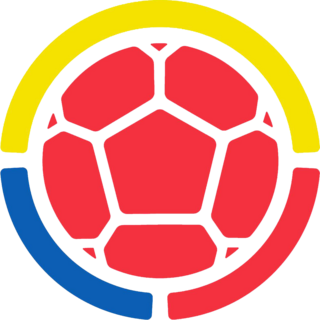
The Colombia national football team represents Colombia in men's international football and is managed by the Colombian Football Federation, the governing body for football in Colombia. They are a member of CONMEBOL and are currently ranked 14th in the FIFA World Rankings. The team are nicknamed Los Cafeteros due to the coffee production in their country. The national team has been a symbol of nationalism, pride, and passion for many Colombians worldwide. Colombia is known for having a passionate fan base, and the team's dances during goal celebrations have been symbolic.
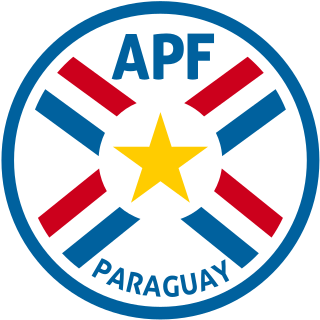
The Paraguay national football team represents Paraguay in men's international football competitions, and are controlled by the Paraguayan Football Association. Paraguay is a member of CONMEBOL. Their nickname is the Albirroja, or red and white. The Albirroja has qualified for eight FIFA World Cup competitions, with their best performance coming in 2010 when they reached the quarter-finals. A regular participant at the Copa América, Paraguay have been crowned champions of the competition on two occasions. Paraguay's highest FIFA World Rankings was 8th and their lowest was 103. Paraguay was awarded second place with Best Move of the Year in 1996 for their rise in the FIFA Rankings.

The Primera Junta or Junta Provisional Gubernativa de las Provincias del Río de la Plata, is the most common name given to the first government of what would eventually become Argentina. It was formed on 25 May 1810, as a result of the events of the May Revolution. The Junta initially only had representatives from Buenos Aires. When it was expanded, as expected, with the addition of representatives from the other cities of the Viceroyalty of the Río de la Plata, it became popularly known instead as the Junta Grande or Junta Provisional Gubernativa de Buenos Aires. The Junta operated at El Fuerte, which had been used since 1776 as a residence by the viceroys.
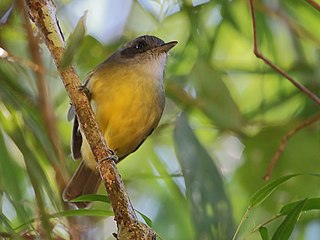
The plain antvireo is a passerine bird species in subfamily Thamnophilinae of family Thamnophilidae, the "typical antbirds". It is found in Mexico, every Central American country except El Salvador, on both Trinidad and Tobago, and in every mainland South American country except Chile, French Guiana, Suriname, and Uruguay.

The Thousand Days' War was a civil war fought in Colombia from 17 October 1899 to 21 November 1902, at first between the Liberal Party and the government led by the National Party, and later – after the Conservative Party had ousted the National Party – between the liberals and the conservative government. Caused by the longstanding ideological tug-of-war of federalism versus centralism between the liberals, conservatives, and nationalists of Colombia following the implementation of the Constitution of 1886 and the political process known as the Regeneración, tensions ran high after the presidential election of 1898, and on 17 October 1899, official insurrection against the national government was announced by members of the Liberal Party in the Department of Santander. Hostilities did not begin until the 11th of November, when liberal factions attempted to take over the city of Bucaramanga, leading to active warfare. It would end three years later with the signing of the Treaty of Neerlandia and the Treaty of Wisconsin. The war resulted in a Conservative victory, and ensured the continued dominance of the Conservative Party in Colombian politics for another 28 years. Colombia's political structure as a unitary state has not been challenged since.
Latin American involvement in international peacekeeping dates back to the start of United Nations peacekeeping efforts with the Organization's founding in the 1940s but has seen a sharp acceleration in recent years.

Historically speaking, bilateral relations between the various countries of Latin America and the United States of America have been multifaceted and complex, at times defined by strong regional cooperation and at others filled with economic and political tension and rivalry. Although relations between the U.S. government and most of Latin America were limited prior to the late 1800s, for most of the past century, the United States has unofficially regarded parts of Latin America as within its sphere of influence, and for much of the Cold War (1947–1991), actively vied with the Soviet Union for influence in the Western Hemisphere.
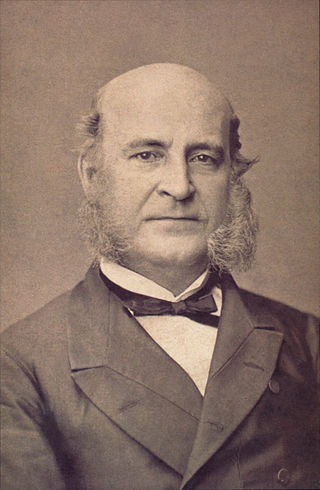
José Maria da Silva Paranhos, Viscount of Rio Branco, was a Brazilian politician, monarchist, diplomat, teacher and journalist. Rio Branco was born in Salvador, in what was then the Captaincy of Bahia, to a wealthy family, but most of the fortune was lost after his parents' deaths early in his childhood. In 1871, Rio Branco became the president of the Council of Ministers for the first time. He would become the Council's longest-serving president, and his cabinet the second longest, in Brazilian history. His government was marked by a time of economic prosperity and the enactment of several reforms. The most important of these initiatives was the Law of Free Birth, which granted freeborn status to children born to slave women. Rio Branco led the government that enacted this law, and its passage increased his popularity. His government was plagued by a long crisis with the Catholic Church that resulted from the expulsion of Freemasons from its lay brotherhoods. After more than four years heading the Cabinet, Rio Branco resigned in 1875. Following a long vacation in Europe, his health swiftly declined and he was diagnosed with oral cancer. Rio Branco died in 1880 and was widely mourned throughout the country. He is regarded by most historians as one of Brazil's greatest statesmen.

The Spanish American wars of independence took place throughout Spanish America during the early 19th century, with the aim of political independence from Spanish rule. Struggles for sovereignty in both hemispheres began shortly after the outbreak of the Peninsular War as a front in the larger Napoleonic Wars, between royalists who favored a unitary monarchy, and patriots who favored either plural monarchies or republics. Thus, the strict period of military campaigns would go from the Battle of Chacaltaya (1809), in present-day Bolivia, to the Battle of Tampico (1829) in Mexico.
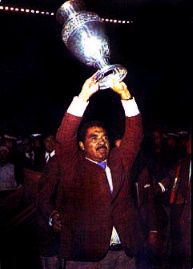
This is a record of Peru's results at the Copa América. Ever since their first Copa América, Peru has had good showings. It is often remembered by fans that Peru was the fourth team to win the South American cup. Even though in 1939 Peru played against only 5 of the South American nations, in 1975 Peru won the cup once more.

The Platine War was fought between the Argentine Confederation and an alliance consisting of the Empire of Brazil, Uruguay, and the Argentine provinces of Entre Ríos and Corrientes, with the participation of the Republic of Paraguay as Brazil's co-belligerent and ally. The war was part of a decades-long dispute between Argentina and Brazil for influence over Uruguay and Paraguay, and hegemony over the Platine region. The conflict took place in Uruguay and northeastern Argentina, and on the Río de la Plata. Uruguay's internal troubles, including the longrunning Uruguayan Civil War, were heavily influential factors leading to the Platine War.

The Uruguayan War was fought between Uruguay's governing Blanco Party and an alliance consisting of the Empire of Brazil and the Uruguayan Colorado Party, covertly supported by Argentina. Since its independence, Uruguay had been ravaged by intermittent struggles between the Colorado and Blanco factions, each attempting to seize and maintain power in turn. The Colorado leader Venancio Flores launched the Liberating Crusade in 1863, an insurrection aimed at toppling Bernardo Berro, who presided over a Colorado–Blanco coalition (fusionist) government. Flores was aided by Argentina, whose president Bartolomé Mitre provided him with supplies, Argentine volunteers and river transport for troops.

The military history of South America can be divided into two major periods – pre- and post-Columbian – divided by the entrance of European forces to the region. The sudden introduction of steel, gunpowder weapons and horses into the Americas would revolutionize warfare. Within the post-Columbian period, the events of the early 19th century, when almost all of South America was marked by wars of independence, also forms a natural historical juncture. Throughout its history, South America has had distinct military features: it has been geographically separated from many major military powers by large oceans; its unique terrain has imposed major logistical challenges, and privileged naval lines of communications.
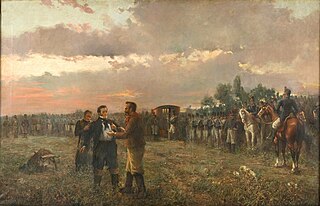
The Decembrist revolution was a military coup in the Buenos Aires Province, Argentina. Juan Lavalle, returning with the troops that fought in the Argentine-Brazilian War, mounted a coup on December 1, 1828, capturing and killing the governor Manuel Dorrego and ultimately closing the legislature. The rancher Juan Manuel de Rosas organized militias that fought against Lavalle and removed him from power, restoring the legislature. However, as the coup had reignited the Argentine Civil Wars, Rosas was appointed governor of the Buenos Aires province to wage the war against the Unitarian League. Both José María Paz, from Córdoba, and Rosas formed a league of provinces. The conflict ended soon after the unexpected capture of Paz, when he mistook enemy troops for his own.

The term Latin America and the Caribbean (LAC) is an English-language acronym referring to the Latin American and the Caribbean region. The term LAC covers an extensive region, extending from The Bahamas and Mexico to Argentina and Chile. The region has over 670,230,000 people as of 2016, and spanned for 21,951,000 square kilometres (8,475,000 sq mi).
The South American territorial disputes are the territorial disputes and litigations that have developed in South America since the aftermath of the continent's wars of independence, which have shaped the current political geography of the region. These conflicts have been resolved through both military and diplomatic means. The most recent conflict in the Americas of this nature was the Cenepa War in 1995, between Ecuador and Peru.